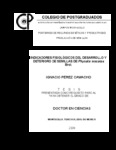| dc.description.abstract | México es centro de origen del tomate de cáscara (Physalis ixocarpa Brot.),
el cual ocupa el quinto lugar entre las especies hortícolas. A pesar de su
importancia, la investigación que existe en esta especie aún es escasa,
particularmente la relacionada con la producción y deterioro de semilla. La
presente investigación se llevó a cabo en tres fases. En la primera se estudió la
actividad de las enzimas sacarosa sintasa e invertasa acida durante el desarrollo
de la semilla y se correlacionó con la evolución de los parámetros de calidad de
semillas. En la segunda se almacenaron semillas cosechadas durante el
desarrollo del cultivo en condiciones contrastantes de temperatura (5.3 y 23.8 ºC)
y humedad relativa (HR) (41.2 y 81.4%) durante 0, 4 y 8 meses, estudiando el
efecto del deterioro en la calidad fisiológica de las semillas. Finalmente, en el
tercer estudio se analizó el efecto del almacenamiento en bodega durante 5 años
sobre parámetros fisiológicos. En la primera fase experimental se encontró que
durante el desarrollo de la semilla, el contenido de carbohidratos solubles aumentó
de 33 a 118 !g g-1 peso fresco, y el contenido de sacarosa en la semilla se
incremento de 13 a 25 !g g-1. En el metabolismo de la sacarosa, la invertasa ácida
tuvo sus niveles más altos a los 15 días post-polinización (DPP) y luego fue
disminuyendo continuamente para llegar a su mínima actividad a los 55 DPP. En
cambio, la sacarosa sintasa resultó indetectable en los primeros 15 DPP, para
después incrementar y alcanzar su máxima actividad a los 35 DPP, y luego
declinar. Estos resultados evidencian que ambas enzimas están presentes y
activas en la semilla de tomate de cáscara, que sirven para metabolizar la
sacarosa que se usa en el crecimiento y acumulación de reservas. En la segunda
fase se observó que después de ocho meses de almacenamiento, sólo se
encontró un deterioro significativo a 23.8 °C y 81.4% HR, ya que causó la
disminución de: germinación, de 69.8 a 29.3%; viabilidad, de 81 a 46%; velocidad
de emergencia de radícula, de 20.39 a 9.88 radículas.día-1; respiración, 16.13 a
6.63 nmol CO2 g-1 s-1 y conductividad eléctrica de la solución de imbibición, 32 a
97.1 µs cm-1g-1. Finalmente, el tercer estudio mostró que después de 5 años, la
viabilidad decreció de 84.5 a 50.8%, la velocidad de emergencia de la radícula de
79 a 34.3 radículas d-1, y la conductividad eléctrica subió de 31 a 80 µs cm-1.
Además, el peso de mil semillas bajó de 1360 a 1140 mg y el peso de 20 plántulas
después de 10 d de sembradas disminuyó de 1306 a 876 mg. Las pérdidas en
germinación de la semilla aumentaron linealmente al aumentar el tiempo de
almacenamiento, con una tasa de reducción de 8.7% anual. La semilla de tomate
de cáscara sólo se puede conservar en esas condiciones por 3 años con 65.8% de
germinabilidad, y sólo por un año con 80% germinabilidad.______Mexico is a center of origin of the husk tomato (Physalis ixocarpa Brot.), it occupies
the fifth place among the horticultural species. In spite of his importance, the
investigation that exists in this species is still scarce, particularly studies about the
production and deterioration of seeds. The investigation was carried out in three
phases. In the first one the activity of saccharose sintasa and invertasa acid
enzymes was studied during of development of the seed and then correlated by
the evolution of the quality parameters of seed. In the second one seeds harvested
during of crop development were stored under contrasting conditions of
temperature (5.3 and 23.8 ºC) and relative moisture (RH) (41.2 and 81.4%) for 0, 4
and 8 months, evaluating the effect of the deterioration in the physiological quality
of the seeds. Finally, in the third study the effect of the storage for 5 years on
physiological parameters was analyzed. In the first experimental phase it was
found that during the development of the seed, the content of soluble
carbohydrates increased from 33 to 118 !g g-1 fresh weight, and the content of
sucrose in the seed increased from 13 to 25 !g g-1 . In the metabolism of the
sucrose, the invertase acid had high levels to 15 days after polinization (DPP) and
then diminished continuously to come to his minimal activity to 55 DPP. On the
other hand, the sucrose synthase turned out to be undetectable in the first 15 DPP,
although later on it increased to reach his maximum activity at 35 DPP, and then
declined. These results demonstrate that both enzymes, are active in the seed of
husk tomato, and serve to metabolize the sucrose that is used in the growth and
accumulation of reserves. In the second phase it was found that after eight months
of storage, only there was a significant deterioration with 23.8 °C and 81.4% RH,
since it caused the decrease of: germination, from 69.8 to 29.3%; viability, from 81
to 46%; emergency speed of radicle, from 20.39 to 9.88 radicles dia-1; respiration,
16.13 to 6.63 nmol CO2 g-1 s-1 and electrical conductivity of the imbibition solution,
32 to 97.1 µs cm-1g-1. Finally, the third study showed that after 5 years, the viability
decreased from 84.5 to 50.8%, the emergency speed of the radicle from 79 to 34.3
radicles d-1 and the electrical conductivity raised from 31 to 80 µs cm-1. Also, the
weight of thousand seeds lowered from 1360 to 1140 mg and the weight of 20
seedlings after 10 d of sowed diminished from 1306 to 876 mg. The losses in
germination of the seed increased linearly on having increased the time of storage,
with a rate of reduction per year of 8.7%. The seed of husk tomato can only be
preserved in these conditions for 3 years with 65.8% of germinability and only for
one year with 80% germinability. | es |

